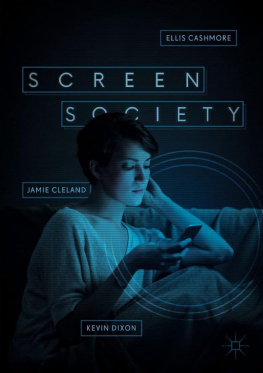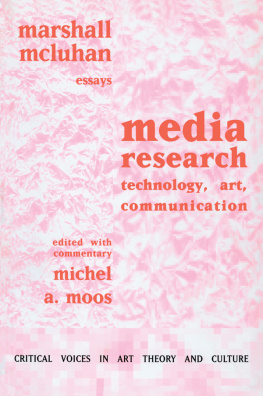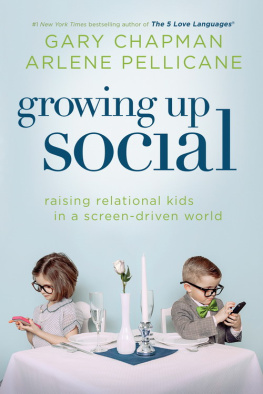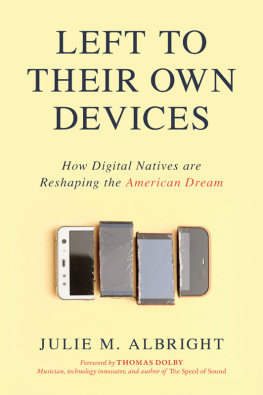Ellis Cashmore
Jamie Cleland
Kevin Dixon
Screen Society

Ellis Cashmore
School of Languages and Social Sciences Aston University
Birmingham, UK
Jamie Cleland
UniSA Business School University of South Australia Adelaide, Australia
Kevin Dixon
School of Social Sciences, Humanities and Law
Teesside University Middlesbrough, UK
ISBN 978-3-319-68163-4 ISBN 978-3-319-68164-1 (eBook)
https://doi.org/10.1007/978-3-319-68164-1
Library of Congress Control Number: 2018937875
The Editor(s) (if applicable) and The Author(s) 2018
This work is subject to copyright. All rights are solely and exclusively licensed by the Publisher, whether the whole or part of the material is concerned, specifically the rights of translation, reprinting, reuse of illustrations, recitation, broadcasting, reproduction on microfilms or in any other physical way, and transmission or information storage and retrieval, electronic adaptation, computer software, or by similar or dissimilar methodology now known or hereafter developed.
The use of general descriptive names, registered names, trademarks, service marks, etc. in this publication does not imply, even in the absence of a specific statement, that such names are exempt from the relevant protective laws and regulations and therefore free for general use.
The publisher, the authors and the editors are safe to assume that the advice and information in this book are believed to be true and accurate at the date of publication. Neither the publisher nor the authors or the editors give a warranty, express or implied, with respect to the material contained herein or for any errors or omissions that may have been made. The publisher remains neutral with regard to jurisdictional claims in published maps and institutional affiliations.
Cover credit: Joel Sorrel/Getty Images Printed on acid-free paper
This Palgrave Macmillan imprint is published by the registered company Springer International Publishing AG part of Springer Nature
The registered company address is: Gewerbestrasse 11, 6330 Cham, Switzerland
Screen Society: Timeline
1696
Demonstration in England of a device that will become known as a magic lantern, a primitive form of image projector used for showing images on a screen.
1839
Louis-Jacques-Mand Daguerre presents the first practical photographic process to the French Academy of Sciences, establishing the technology that will yield practical photography. In the same period, magic lantern shows are commonplace in Europe and America.
1850s
Theatrical entertainment grows in popularity, principally through a music hall, which offers a mix of songs, comedy, conjuring and speciality acts. Audiences sit in spacious theatres with seats and a stage on the understanding that they respect others comfort. GAMECHANGER
1895
In Paris, Auguste and Louis Lumire exhibit their kinetoscope, which lets viewers view moving images through a peephole. This starts a period of rapid experimentation, leading to the development of the cinematograph, which allows simultaneous viewing by multiple people.
1910s
The popularity of the cinematograph encourages the production of silent films to entertain paying audiences. By the end of the decade, there will be a fledgling film industry. GAMECHANGER
1921
The Kid , a silent black and white film featuring Charlie Chaplin is released.
1922
BBC Radio launches. Radio will become the dominant broadcast medium of the period.
1927
The Jazz Singer is released. This is the most successful film with sound to date.
1930
Film is established as a mainstream entertainment, supplanting theatre.
1936
BBC launches Britains first regular tv service at 3 p.m. on November 2, but only for two hours per day and to London audiences only.
1937
Walt Disney Studios (later to become Disney) release their first feature film, Snow White and the Seven Dwarfs ; an animated production that offers a new type of family entertainment.
1939
Gone with the Wind , the 221-minute epic film based on Margaret Mitchells novel, sets new standards in cinema and will go on to become one of the highest grossing films (when adjusted for price inflation).
1941
Konrad Zuse creates the first functional electro-mechanical binary programmable computer, a forerunner of todays devices.
1949
BBC televises beyond London.
1950s
Sales of domestic television rise dramatically.
1952
Cinema responds to the challenge to its popularity with colour stereoscopic 3D and CinemaScope.
Bell Labs, the American research and scientific development organization, invent the modem, a device that converts digital signals back to electrical signals and back again, enabling communication between computers.
1951
I Love Lucy , which started as a radio comedy, is turned into a television sitcom and airs on American network CBS. The series will run till 1957 and will be screened internationally. Such is the popularity of the show that it will greatly assist the rise of television as a genuine challenger to cinema.
1960
The first universal standard for computers ASCII (American Standard Code for Information Exchange) is developed and permits machines from different manufacturers to exchange data.
1963
Abraham Zapruder films the assassination of US President John F. Kennedy on his Model 414 PD Bell & Howell Zoomatic Director Series camera. The 26.6 seconds of footage is the only film of the shooting and will assume iconic status in the years that follow. Zapruders camera is one of the home movie cameras that are popular in the early 1960s. The films are developed and shown on portable screens years before video (see below, 1978).
1965
Polaroids Swinger camera allows users to see photographs without sending them off to the chemist for development.
1967
Decca introduce colour television with its model CTV 25.
1969
An estimated 600 million people watch the Apollo 11 landing on the moon live on television, a world record until 1981, when 750 million people watch the wedding of the Prince of Wales and Lady Diana Spencer.
A computer-to-computer link is established on the Advanced Research Projects Agency Network, or ARPANET, which is funded by the US government. The first transmission is sent by a UCLA student programmer to Stanford Research Institutes host computer. Fifteen years later, the first email will be sent. GAMECHANGER
1970
The first IMAX screen is unveiled in Osaka, Japan.
1971
Ray Tomlinson implements the first email programme on the ARPANET system, a precursor to the internet.
1973
Flexible removable, magnetic disks, popularly known as floppy disks enable users to save and transport documents, though a whole disk cant store a whole song.
CEEFAX, a text information system is integrated into television sets.
1975
Sony introduces the Betamax machine: this records and plays back television programmes on plastic cassettes (about as big as hardback books), enabling viewers to tape and watch programmes at their own convenience.
1976
JVC release the first video home system, or VHS, machines in Japan (then in the UK and USA in early 1977). This rivals Sonys Betamax (see above, 1975).
1980
The Sony Walkman cassette tape player is launched. Sales will reach 200 million worldwide.
1981
The Acorn BBC Micro Computer is used in schools.
1982
Kilnam Chon, a professor at Keio University in Japan, develops the first internet connection in Asia.
Next page





